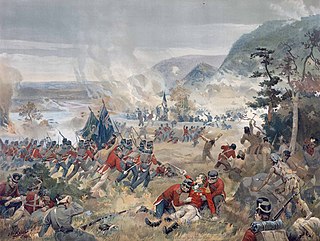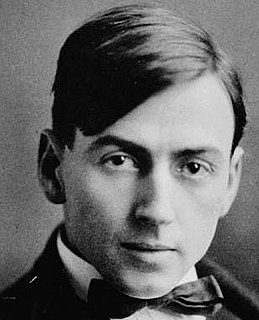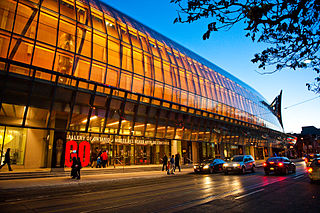
Niagara-on-the-Lake is a town in Ontario, Canada. It is located on the Niagara Peninsula at the point where the Niagara River meets Lake Ontario, across the river from New York, United States. Niagara-on-the-Lake is in the Niagara Region of Ontario and is the only town in Canada that has a lord mayor. It has a population of 17,511 (2016).

The Battle of Queenston Heights was the first major battle in the War of 1812. Resulting in a British victory, it took place on 13 October 1812 near Queenston, Upper Canada.

Thomas John Thomson was a Canadian artist active in the early 20th century. During his short career he produced roughly 400 oil sketches on small wood panels along with around 50 larger works on canvas. His works consist almost entirely of landscapes depicting trees, skies, lakes, and rivers. His paintings use broad brush strokes and a liberal application of paint to capture the beauty and colour of the Ontario landscape. Thomson's accidental death at 39 by drowning came shortly before the founding of the Group of Seven and is seen as a tragedy for Canadian art.

The Queenston Heights is a geographical feature of the Niagara Escarpment immediately above the village of Queenston, Ontario, Canada. Its geography is a promontory formed where the escarpment is divided by the Niagara River. The promontory forms a cliff face of approximately 100 m.

Queenston is a compact rural community and unincorporated place 5 kilometres (3.1 mi) north of Niagara Falls in the Town of Niagara-on-the-Lake, Ontario, Canada. It is bordered by Highway 405 to the south and the Niagara River to the east; its location at the eponymous Queenston Heights on the Niagara Escarpment led to the establishment of the Queenston Quarry in the area. Across the river and the Canada–US border is the village of Lewiston, New York. The Lewiston-Queenston Bridge links the two communities. This village is at the point where the Niagara River began eroding the Niagara Escarpment. During the ensuing 12,000 years the Falls cut an 11 kilometres (6.8 mi) long gorge in the Escarpment southward to its present-day position.

The Art Gallery of Ontario is an art museum in Toronto, Ontario, Canada. The museum is located in the Grange Park neighbourhood of downtown Toronto, on Dundas Street West between McCaul and Beverley streets. The museum's building complex takes up 45,000 square metres (480,000 sq ft) of physical space, making it one of the largest art museums in North America. In addition to exhibition spaces, the museum also houses an artist-in-residence office and studio, dining facilities, event spaces, gift shop, library and archives, theatre and lecture hall, research centre, and a workshop.

Alexander Young Jackson was a Canadian painter and a founding member of the Group of Seven. Jackson made a significant contribution to the development of art in Canada, and was successful in bringing together the artists of Montreal and Toronto. He exhibited with the Group of Seven from 1920. In addition to his work with the Group of Seven, his long career included serving as a War Artist during World War I (1917–19) and teaching at the Banff School of Fine Arts, from 1943 to 1949. In his later years he was artist-in-residence at the McMichael Canadian Art Collection in Kleinburg, Ontario.

Homer Ransford Watson was a Canadian landscape painter. He has been characterized as the painter who first painted Canada as Canada, rather than as a pastiche of European painting. He was a member and president (1918–1922) of the Royal Canadian Academy of Arts, as well as a founding member and first president (1907–1911) of the Canadian Art Club. Although Watson had almost no formal training, by his mid-1920s he was well known and admired by Canadian collectors and critics, his rural landscape paintings making him one of the central figures in Canadian art from the 1880s until the First World War.

King's Highway 405, also known as Highway 405 and the General Brock Parkway, is a 400-Series Highway in the Canadian province of Ontario connecting the Queen Elizabeth Way (QEW) near St. Catharines with the Lewiston–Queenston Bridge in the village of Queenston. It then crosses the Niagara River, where it encounters the international border with the United States and continues into New York as Interstate 190 (I-190).

The McMichael Canadian Art Collection (MCAC) is an art museum in Vaughan, Ontario, Canada. The museum is located on a 40 hectares property in Kleinburg, an unincorporated village in Vaughan. The property includes the museum's 7,900 square metres (85,000 sq ft) main building, a sculpture garden, walking trails, and the cemetery for six members of the Group of Seven.
David Kenneth Roy Thomson, 3rd Baron Thomson of Fleet is a Canadian hereditary peer and media magnate. Upon the death of his father in 2006, Thomson became the chairman of Thomson Corporation and also inherited his father's British title, Baron Thomson of Fleet. After the acquisition of Reuters in 2008, Thomson became the chairman of the merged entity, Thomson Reuters.

The Jack Pine is a well-known oil painting by Canadian artist Tom Thomson. A representation of the most broadly distributed pine species in Canada, it is considered an iconic image of the country's landscape, and is one of the country's most widely recognized and reproduced artworks.

The Niagara Parks Commission, commonly shortened to Niagara Parks, is an agency of the Government of Ontario which maintains the Ontario shoreline of the Niagara River.
The Niagara Parkway, formerly known as Niagara Boulevard and historically as the Niagara Road, is a scenic road in the province of Ontario that travels on the Canadian side of the Niagara River from the town of Fort Erie to Niagara-on-the-Lake. The portion north of Table Rock in the city of Niagara Falls is designated as an Ontario Scenic Highway. Niagara Boulevard originally referred only to the section from Fort Erie to Chippawa.

Centennial Parkway, is a Lower City arterial road in Hamilton, Ontario, Canada. It is best known as the western terminus of former King's Highway 20, now maintained by the City of Hamilton. It starts off as Upper Centennial Parkway, a mountain-access road in the City right before the Canadian Pacific Railway line at the backend of Battlefield Park and is a two-way street throughout that extends north over the Queen Elizabeth Way and ends at Beach Boulevard/ Van Wagners Beach Road in front of Confederation Park.
The Ontario Association of Art Galleries was established in 1968 to encourage development of public art galleries, art museums, community galleries and related visual arts organizations in Ontario, Canada. It was incorporated in Ontario in 1970, and registered as a charitable organization. It is a successor organization to the Southern Ontario Gallery Group founded in 1947, renamed the Art Institute of Ontario in 1952. The association runs courses and workshops and provides assistance to art galleries in areas such as conservation and arranging exhibitions. Most member galleries participate in a reciprocal admissions program, where membership of one gallery gives admission to the others. The organization provides a liaison between galleries and the Ontario Arts Council.

The McMaster Museum of Art (MMA) is a non-profit public art gallery at McMaster University in Hamilton, Ontario. The museum is located in the centre of the campus, attached to Mills Memorial Library and close to the McMaster University Student Centre.
Robert R. Whale (1805–1887) was an English-born Canadian painter.

Northern River is a 1914–15 oil painting by Canadian painter Tom Thomson. The work was inspired by a sketch completed over the same winter, possibly in Algonquin Park. The completed canvas is large, measuring 115.1 × 102.0 cm. Painted over the winter of 1914–15, it was completed in Thomson's shack behind the Studio Building in Toronto. The painting was produced as he was entering the peak of his short art career and is considered one of his most notable works. In 1915 it was purchased by the National Gallery of Canada in Ottawa and has remained in the collection ever since.

Tom Thomson (1877–1917) was a Canadian painter from the beginning of the 20th century. Beginning from humble roots, his development as a career painter was meteoric, only pursuing it seriously in the final years of his life. He became one of the foremost figures in Canadian art, leaving behind around 400 small oil sketches and around fifty larger works on canvas.




















